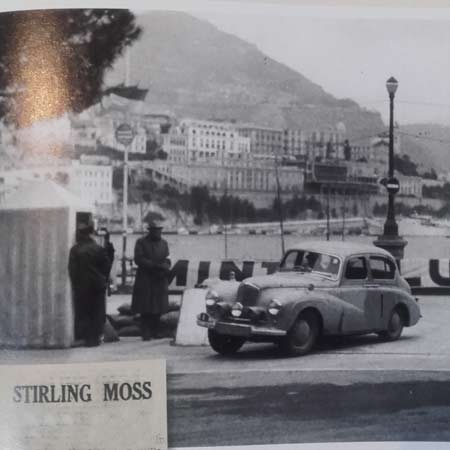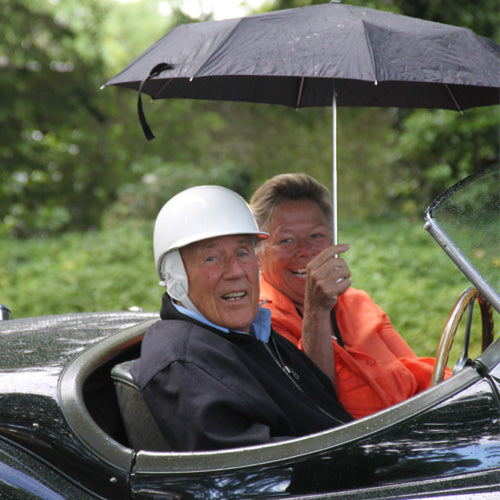
Let's not forget Stirling Moss was also a star of the stage
Stirling Moss, rally driver. That’s not a phrase you’ll find easily, if at all, in recent media reports announcing the retirement from public life of our favourite English knight. Yet any pieced-together picture of Stirling’s career must show rallying for the jigsaw to be complete.
News stories of Stirling’s retirement have contained accolades aplenty for the best Formula 1 driver never to win the World Championship, scoring 16 Grand Prix victories from 66 starts. Praise for his giant-slaying victory in the 1961 Monaco and German Grands Prix, peddling a privateer Lotus 18 so hard it defeated the factory-entered ‘shark-nose’ Ferraris. Astonishment at the pace he set in a Mercedes-Benz 300 SLR to win the 1955 Mille Miglia, hurtling along closed public roads for 992 miles at an average speed of 99 mph. Regret for the accident at Goodwood in April ’62 that truncated his driving career and so nearly ended his life. And admiration for the work ethic that endured until far into his ninth decade and the intervention of ill-health. But of his rallying exploits, barely a peep.

In fact Stirling Moss, racing driver, ventured onto the rally stages for no fewer than eight events, and most of these were serious. There was the ’54 Great American Mountain Rallye in a Sunbeam Alpine, a three-day, 1100-mile adventure in which Stirling and many other entrants failed to be classified as finishers because roads in the Green Mountains of Vermont were made almost impassable by snow and ice. There was his second-in-class in a Jaguar XK 120 Coupé on the ’52 Lyons-Charbonnières Rally, a 1550-mile run through the Jura Mountains and French Alps which drivers rated as second in difficulty only to the Liège-Rome-Liège marathon.


There were three outings from ’52 to ’54 (two in a Sunbeam-Talbot 90, one in a Sunbeam-Talbot Alpine) on the Monte Carlo, the most important rally in the world, with second place overall at the first attempt. And there were three runs in Sunbeam-Talbots (once in a 90, twice in an Alpine) from ’52 to ’54 on the Coupe des Alpes, a punishing six-day event which traversed 31 of the highest mountain passes in France, Switzerland, Italy and Austria - and where, despite winning a coveted Gold Cup for a penalty-free run every year, Stirling privately admitted to suffering something akin to a small-scale nervous breakdown.
 This surprising confession is found handwritten in Stirling’s personal diary from 1954, one of the many primary sources drawn-upon in Philip Porter’s meticulously researched book Stirling Moss -The Definitive Biography (Volume 1). Moss made the diary entry shortly after completing the final section of the Coupe des Alpes by driving (with co-driver John Cutts on the maps) for “24 hours solid.” That’s a full day and night speeding over mountain passes made slippery by rain, snow and ice, knowing that a single misjudgement or momentary lapse of concentration could send the car smashing into a rock face or skating over a precipice. Moss wrote in his diary that as soon as this exhausting job was completed, when at last he was able to stop and rest after driving so hard for so long to meet time-over-distance targets, he “collapsed from nervous strain and couldn’t stop shaking.”
This surprising confession is found handwritten in Stirling’s personal diary from 1954, one of the many primary sources drawn-upon in Philip Porter’s meticulously researched book Stirling Moss -The Definitive Biography (Volume 1). Moss made the diary entry shortly after completing the final section of the Coupe des Alpes by driving (with co-driver John Cutts on the maps) for “24 hours solid.” That’s a full day and night speeding over mountain passes made slippery by rain, snow and ice, knowing that a single misjudgement or momentary lapse of concentration could send the car smashing into a rock face or skating over a precipice. Moss wrote in his diary that as soon as this exhausting job was completed, when at last he was able to stop and rest after driving so hard for so long to meet time-over-distance targets, he “collapsed from nervous strain and couldn’t stop shaking.”
Moss’s bravery and skill were never in question - indeed, in both regards he often seemed in a league of his own - but on the Coupe des Alpes even he bumped up against his physical and mental limits. This wasn’t quite stage fright, but it might be described as post traumatic stage disorder. Rallies could be such an unforgiving test of courage and commitment and skill and stamina, even for a driver so supernaturally talented. And ‘a roundy-roundy man’ from the circuits could still go out there and beat the rallying specialists at their own game, even at the highest international level. Surely these elements of the Stirling Moss story are worth retelling and remembering.
By Phillip Bingham






Leave a comment
This site is protected by hCaptcha and the hCaptcha Privacy Policy and Terms of Service apply.